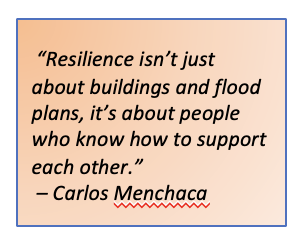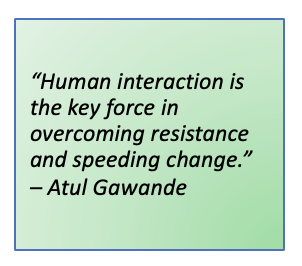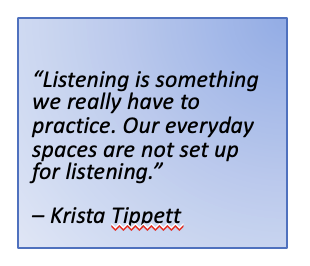Communities are struggling with inter-related challenges: social isolation, mental health and addiction issues, lack of affordable housing, and disconnects among people of different generations, races, classes, and political parties. How can we create the spaces in our communities where we can turn to each other to reflect on what is changing, find creative solutions, and build the trust and consensus to take action?
Intergenerational Conversations
I’m happy to share this story of a community conversation approach designed to strengthen mutual understanding and build relationships across generations in a community. I was working with a team from the White River Valley Consortium (WRVC), which is a collaboration of 14 towns near the White River in Vermont working to create a region with opportunity and a sense of  belonging for people of all incomes, races, ages, and backgrounds. One area of action is to “model a new way of working together by collaborating on housing solutions for entry-level workers and beginning entrepreneurs.”
belonging for people of all incomes, races, ages, and backgrounds. One area of action is to “model a new way of working together by collaborating on housing solutions for entry-level workers and beginning entrepreneurs.”
In a recent forum on climate readiness, the team had seen a generational divide. In broad strokes, young people struggle to find affordable housing. Older people and longer-term residents tend to resist new construction and housing for renters and people with lower incomes.
We created an intergenerational dialogue to offer a space for people from different generations to hear each other’s stories and experiences directly. Years ago, I met Barbara Simonetti, a facilitator, who had shared this intergenerational dialogue approach she’d designed for some women’s gatherings. I’ve carried the idea like a seed, waiting for the right time to plant it. This was it. I want to thank Barbara for her inspiration.
So back to the story, I suggested this approach to a dialogue:
- Invite people from many different generations in a community to a conversation.
- Group the participants by age, e.g., a group for those under 30, another for 30-50 years old, and another group for those over 50.
- At the event, welcome everyone and introduce the question to discuss. We asked: “Share a story of what it has been like to create a home here. What was positive and what was challenging?”
- Invite people to join a small group conversation with people in their same age group to discuss the question for about 25-30 minutes.
- Then come back together and mix people into small groups where you have a mix of people from each age group. Ask them to each share the highlights of the previous conversation and continue discussing the question for 25-30 minutes.
- Then invite people to return to the original conversation with people in their age group and discuss: What moved you about others’ experiences of making a home here? Each group listens for common themes for another 15-20 minutes.
- People are then invited back into the full group to share insights and ideas.
- In a closing circle, we invite each person to briefly share a highlight of the experience.
 We bought gift cards to the local general store and handed these out, asking people to set up a coffee date with someone they met here tonight.
We bought gift cards to the local general store and handed these out, asking people to set up a coffee date with someone they met here tonight.
How It Went
We piloted this approach in the town of Tunbridge, Vermont and sent out invitations. About 20 people with a range of ages gathered on a rainy evening in early August at the town library. While there was a diversity of ages, as a pilot, we gathered those willing and able to attend an evening discussion, so other facets of the diversity may not have been represented. The team arranged for a welcoming table of food.
The intergenerational conversation process offered:
- A way for people to talk with others they don’t usually interact with.
- A place for newcomers to the town in each generation to meet people, learn about the history of the community, and find ways to get involved.
- A means for people to understand how broader trends and changes were impacting people locally (via hearing personal stories). Examples included rising housing prices, impacts of people working remotely during the pandemic and moving to rural areas.
- An opportunity for discussion of issues needing attention, such as creative housing solutions that could allow more affordable options, such as house sharing, accessory dwelling units; challenges for young people to find livable wage jobs and affordable housing; and the desire for more community spaces.
There was a spirit of warmth and appreciation in the closing circle. Here are some quotes from the team members when we reflected on how it went:
“We let people express themselves. We didn’t go in with an agenda or demand solutions right away; the point was to make space for people to talk with each other.”
“The similarities in stories between generations surprised me. I heard from both young and old people how lucky they felt to find housing.”
“People have so much in common if you give them a chance to talk with each other.”
“It was nice to see people exchanging contact information at the end. I heard people making plans to meet up – intergenerationally. The gift card for coffee seemed to work.”
We offered a similar conversation in the town of Royalton in September that had similar positive results, especially around connecting newcomers and seeing areas of common interest in helping younger people find housing and older people open to finding ways to transfer their property to help younger people get access.
Next Steps
These conversations are a starting point to deeper conversations on how to find solutions to the inter-related challenges facing communities. Our team recognized that to get creative on addressing the housing challenges involves solutions that have upsides and downsides for different people. Our sense is that when people have personal connections to the issues with their own experience or knowing people affected, that this will contribute to the social willingness to make changes.
You might like to check out our Resources page full of links about how to host these kinds of gatherings.
